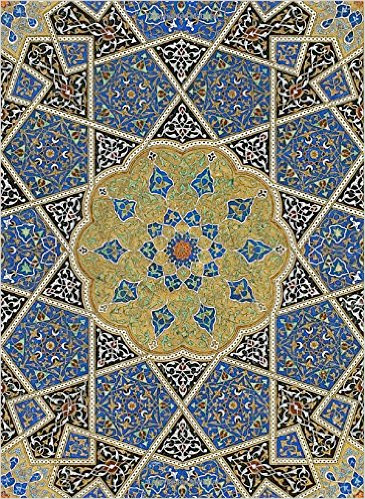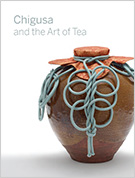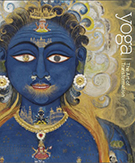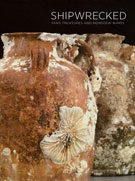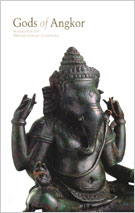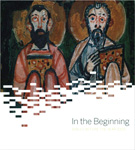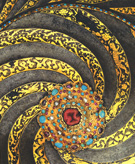Exhibition Catalogues
The Art of the Qur’an: Treasures from the Museum of Turkish and Islamic Arts
Massumeh Farhad and Simon Rettig
With contributions by François Déroche, Edhem Eldem, Jane McAuliffe, Sana Mirza, and Zeren Tanindi
Thousands of sumptuous Qur’an manuscripts and loose pages, penned by celebrated calligraphers and embellished by skilled illuminators and bookbinders over the centuries, are now housed in the Museum of Turkish and Islamic Arts (TIEM) in Istanbul, Turkey. The formation of this one-of-a-kind collection and the history of TIEM are explored in this companion publication to the groundbreaking exhibition The Art of the Qur’an.
The book introduces the Qur’an and traces its transformation from a fleeting, orally transmitted Message into a fixed, written Text that has played a central role in the artistic culture of the Islamic world. Particular attention is given to the formal development of Qur’anic manuscripts over a thousand years and the concurrent evolution of calligraphy and illumination, two distinct features of the arts of the book in the region. Volumes were completed in Herat, Tabriz, Cairo, Baghdad, Mosul, Damascus, and Istanbul. Over the centuries they were created in the Umayyad and Abbasid Near East, Seljuq Iran and Anatolia, the Mongol Il-Khanid and Timurid empires, Mamluk Cairo, and the Safavid and Ottoman empires. Members of the Ottoman elite acquired these fine manuscripts and offered them as gifts to cement political and military relationships or as rewards for loyalty and service. Many Qur’ans were donated to public and religious institutions to express personal piety and to secure power and prestige.
With approximately 260 color and black-and-white illustrations, many of them full page in size. Includes in-depth descriptions of almost seventy works from TIEM and the Smithsonian’s Freer│Sackler. Published in conjunction with the exhibition The Art of the Qur’an: Treasures from the Museum of Turkish and Islamic Arts, on view at the Arthur M. Sackler Gallery, Smithsonian, from October 15, 2016, through February 20, 2017.
Publisher: Arthur M. Sackler Gallery, Smithsonian Institution
Publication date: October 2016
Language: English
Pages: 384
Cloth edition distributed by Smithsonian Books
Cloth: ISBN 978-1-58834-578-3
Paper: ISBN 978-0-934686-40-2
Sōtatsu
James T. Ulak and Yukio LippitWith Furuta Ryō, Nakamachi Keiko, Noguchi Takeshi, Okudaira Shunroku, and Ōta Aya. Edited by Jane Lusaka.
Tawaraya Sōtatsu was one of the most innovative and imaginative artists of the seventeenth century, faded into near obscurity for the next two hundred years, and today is one of the most revered painters in the history of Japanese art. His remarkable story is recounted in Sōtatsu, a comprehensive and lavishly illustrated book featuring insightful essays by leading scholars from the United States and Japan. The artist's life and craft are illuminated in this 368-page volume through a close examination of his contemporaries, his evolution as a master painter, and his increasing stature in Japan and the West, thanks in part to the efforts of collector Charles Lang Freer.
With 308 black-and-white and color illustrations. Published by the Smithsonian’s Arthur M. Sackler Gallery in conjunction with the exhibition Sōtatsu: Making Waves (October 24, 2015–January 31, 2016).
Publisher: Arthur M. Sackler Gallery, Smithsonian Institution
Publication date: October 2015
Language: English
Pages: 368 pages, including four 8-page gatefolds
Cloth edition distributed by Smithsonian Books/Random House
Cloth: 978-1-588345-07-3
Paper: 978-0-934686-75-4
Chigusa and the Art of Tea
Louise Allison Cort and Andrew M. WatskyWith Takeuchi Jun’ichi and Oka Yoshiko. Additional contributions by Li Baoping, Li Jianan, Nishida Hiroko, Omori Masashi, Inoue Kikuo, Satoh Rumi, Yoshioka Akemi, Chika Mouri, Blythe McCarthy, Kumakura Isao, and Julia Meech.
It was admired for centuries, considered a vessel worthy of display, adornment, and contemplation. Now Chigusa and the Art of Tea traces the journey of this tea-leaf storage jar through seven centuries, from its humble beginnings in Song or Yuan dynasty China to its veneration as a named object in sixteenth-century Japan. That name—Chigusa—distinguished the object and allowed it to be discussed as a discrete entity, much like a person. Named tea jars added a new dimension to chanoyu, the intricate tea practice that focused on the taste of the tea, the utensils used to prepare it, and the ideal environment for aesthetic contemplation. Chigusa and the Art of Tea reveals Chigusa’s significance through the words of tea men, whose meticulously recorded diaries describe their early encounters with the jar. The book also examines the textiles, documents, and accessories that accompanied the jar through its centuries of connoisseurship in Japan—including those prepared in the sixteenth century by its first recorded owner—until its acquisition by the Smithsonian’s Freer Gallery of Art in 2009.
This book is a companion to the exhibition Chigusa and the Art of Tea, on view February 22–July 27, 2014, at the Arthur M. Sackler Gallery.
Publisher: Arthur M. Sackler Gallery, Smithsonian Institution
Distributed by: University of Washington Press
Publication date: 2014
Binding: Paperback
Language: English
Pages: 288
ISBN: 9780934686259
Yoga: The Art of Transformation
By Debra Diamond
Preview the book »
Read the review in the LA Review of Books »
All over the world, millions of people—including 20 million Americans—practice yoga for health benefits and to find spiritual calm. Practitioners and non-practitioners alike are aware of yoga's origins in India. But very few know of yoga's rich visual history, which reveals its profound philosophical underpinnings, its goals of transforming both body and consciousness, the diverse social roles yogic practitioners have played, and its transformations over time and across communities.
Yoga: The Art of Transformation, the world's first examination of yoga's visual history, explores:- yoga's meanings and transformations over time, including its entry into the global arena
- yoga's goals of spiritual enlightenment, worldly power, and health and wellbeing
- the beauty and profundity of Indian art
The book features sculptural masterpieces of historical and divine yogis, exquisite Mughal paintings of militant yogis and romantic heroes, illustrated manuscripts of Hindu philosophy and Islamic divination, monumental images of the chakras (energy centers of the body), and 19th-century photography.
Publisher: Freer Gallery of Art and Arthur M. Sackler Gallery
Publication date: 2013
Pages: 328
ISBN: 978-0-934686-26-6 (pbk.), 978-1-588344-59-5 (cloth)

On sale in the museum shop: $16.00
The Peacock Room Comes to America
By Lee Glazer
The Peacock Room Comes to America documents the history of Whistler’s Peacock Room and its recent re-installation with Asian ceramics collected by Charles Lang Freer. Lee Glazer, curator of American art, looks at Freer’s acquisition of the Peacock Room and how he incorporated it into his home in Detroit. There, Freer filled its shelves with ceramics from China, Korea, Syria, and Iran, using the room as a type of aesthetic laboratory where color harmonies could be appreciated. Other sections of the book provide insight into Whistler’s Princess from the Land of Porcelain, the conservation of the room, and the curator’s perspective on the project. New photography of the room is bolstered by the inclusion of archival images.
Publisher: Freer Gallery of Art, Smithsonian Institution
Publication date: 2012
Binding: Paperback
Language: English
Pages: 64
ISBN: 978-0-934686-20-4 (pbk.)
The Imperial Image: Paintings for the Mughal Court
Revised and expanded edition
Milo Cleveland Beach
For centuries in the Islamic world, books have been treasured as precious objects worthy of royal admiration. This was especially true in Muslim India, where generations of Mughal emperors—from Babur and Humayun to Akbar, Jahangir, Shah Jahan, and Awrangzeb—commissioned and collected volumes of richly illuminated manuscripts and lavishly illustrated folios. They assembled workshops of the leading artists and calligraphers to produce the books that filled their extensive libraries. Today, those works remain a vibrant part of India’s cultural and artistic history in the sixteenth and seventeenth centuries.
In this revised and expanded edition of his popular 1981 book, Dr. Milo Beach presents the superb collection of Mughal painting in the Freer Gallery of Art. He adds many of the outstanding works that entered the collection with the opening of the Arthur M. Sackler Gallery in 1987. Together, the Freer and Sackler Galleries, the Smithsonian’s museums of Asian art, have the distinction of being one of the world’s leading repositories of Mughal art. The introductory essay examines the Mughal art of the book and traces the contributions of a succession of rulers in Muslim India. To establish a broader context for these manuscripts and albums, pre-Mughal images, paintings from the Deccan, and works from the later British period are included.
Full-color illustrations in the catalogue section welcome close examination of the colorful and intricate details that enliven these folios. Brief artist biographies and an extensive bibliography complete this updated volume.
Publisher: Freer Gallery of Art and Arthur M. Sackler Gallery, and Mapin Publishing
Publication date: 2012
Pages: 232 pages
Language: English
ISBN: 978-0-934686-11-2 (cloth)
Shipwrecked: Tang Treasures and Monsoon Winds
Edited by Regina Krahl, John Guy, J. Keith Wilson, and Julian Raby
With contributions by Alison Effeny, Michael Flecker, John Guy, Jessica Hallett, Hsieh Ming-liang, Regina Krahl, Li Baoping with Chen Yuh-shiow and Nigel Wood, Liu Yang, François Louis, Qi Dongfang, Wang Gungwu, Tom Vosmer, J. Keith Wilson
Twelve centuries ago, a merchant ship—an Arab dhow—foundered on a reef off the coast of Belitung, a small island in the Java Sea. On board were lead ingots, bronze mirrors, spice-filled jars, intricately worked vessels of silver and gold, and more than 60,000 glazed bowls, ewers, and other ceramics. The ship remained buried at sea for more than a millennium, its contents protected from erosion by their packing and the conditions of the silty sea floor. It wasn’t until 1998 that fishermen discovered the wreck, lying in shallow waters less than three kilometers offshore.
The companion catalogue to an internationally traveling exhibition, Shipwrecked: Tang Treasures and Monsoon Winds documents one of the most important archaeological revelations of the twentieth century. Not only was the Belitung wreck the oldest Arab vessel discovered in Asian waters, but it also contained the largest group of Tang dynasty artifacts ever found. The archaeological recovery of both ship and cargo has allowed for a radical reappraisal of the Maritime Silk Route to China, answering questions on the nature of Asian sea trade with far greater certainty than was possible before.
Through more than 400 gorgeous photographs and essays by international experts, Shipwrecked tells two stories: of the ship and the men who sailed it, and of the cargo, its production and markets. The vast capacity and technical sophistication of China’s kilns are reflected in the number and variety of the ceramic goods, which simultaneously cast light on contemporary West Asian taste. Meanwhile, the glamour of the silver and gold objects speak of diplomatic ties and tribute, although their ultimate destination remains a mystery.
While its long voyage was interrupted, the Belitung ship has opened a route from the past to the present, which we are now able to navigate at least part of the way. Shipwrecked combines art, history, and marine archaeology to create a dramatic narrative of Chinese ceramic production during the fabled Tang dynasty and shows us a China very much at the center of the world. Part adventure story, part maritime archaeological expedition, part historical look into ninth-century Chinese economy, culture, and trade, Shipwrecked is a fascinating journey back in time.
Publisher: Arthur M. Sackler Gallery, Smithsonian Institution, the National Heritage Board, Singapore, and the Singapore Tourism Board
Cloth edition distributed by Smithsonian Books
Publication date: 2010
Binding: Paperback, cloth
Language: English
Pages: 328
ISBN: 978-0-934686-18-1 (pbk.)
ISBN 978-1-58834-305-5 (cloth)
Gods of Angkor: Bronzes from the National Museum of Cambodia
Louise Allison Cort and Paul Jett, editors
With essays by Ian Glover, Hiram Woodward, and John Guy
A remarkable group of seven bronze figures was unearthed in Kampong Cham province, Cambodia, in 2006. These sixth- and seventh-century Buddhist sculptures, two of which were Chinese, ultimately were acquired by the National Museum of Cambodia. There they became one of the first projects of the institution’s Metal Conservation Laboratory, created with help from the Department of Conservation and Scientific Research at the Freer Gallery of Art and Arthur M. Sackler Gallery in Washington, DC. The newly conserved figures were presented for the first time outside Cambodia in the exhibition Gods of Angkor: Bronzes from the National Museum of Cambodia, on view at the Sackler Gallery in 2010 and at the J. Paul Getty Museum, Los Angeles, in 2011.
The accompanying catalogue celebrates not only the collaborative efforts of the Cambodian and US museums to restore and interpret these important images, but also the accomplishments of Khmer bronze casters from the third century BCE to the fourteenth century CE. The authors decipher the makeup and meaning of bronze or figural images, ritual vessels, and other objects, placing them in the context of Southeast Asian life and worship from prehistoric times through the pre-Angkorian and Angkorian eras. Together, the bronzes reveal vivid details of the artistic and religious interactions of the Khmer with their neighbors.
Publisher: Arthur M. Sackler Gallery, Smithsonian Institution
Distributed by: University of Washington Press and Silkworm Books
Publication date: 2010
Binding: Paperback
Language: English
Pages: 158
ISBN: 978-0934686-17-4
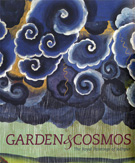
On sale in the museum shop: $40.00
Garden and Cosmos: The Royal Paintings of Jodhpur
Debra Diamond, Catherine Glynn, and Karni Singh Jasol, with contributions by Jason Freitag and Rahul Jain"Would you like to reach Nirvana?" asked the Times of London when Garden and Cosmos traveled to the British Museum in 2009. Deemed "remarkable," by the Independent, the highly praised exhibition featured exquisite paintings that had never been displayed outside of India and opened viewers' eyes to the culture of Jodhpur in Rajasthan in the seventeenth, eighteenth, and nineteenth centuries.
The catalogue is a richly illustrated volume that portrays all the visual splendor of the exhibition. Images of sensuous parties in royal court pavilions and idyllic landscapes for Hindu deities capture the appeal of lush gardens in a desert kingdom. Large fields of shimmering, pulsating color convey the nature of the cosmos, a sublimely minimal style inspired by hatha-yoga metaphysics. The authors meticulously describe and date each painting; identify manuscripts, artists, subjects, and personages; and situate the paintings in the geographic, cultural, and historical landscape of north India. Winner of the prestigious 2010 Alfred H. Barr, Jr., Award presented by the College Art Association.
Publisher: Freer Gallery of Art and Arthur M. Sackler Gallery
Publication date: 2008
Binding: Paperback
Language: English
Pages: 338
ISBN: 978-0-934686-08-2

On sale in the museum shop: $35 (paper), $50 (cloth)
Falnama: The Book of Omens
Massumeh Farhad with Serpil Bağci; contributions by Kathryn Babayan, Julia Bailey, Cornell H. Fleischer, Maria Mavroudi, Wheeler M. Thackston, Jr., and Sergei TourkinPraised by the New York Times as "a highly important exhibition book," this lavishly produced catalogue reproduces illustrated texts from the groundbreaking exhibition at the Arthur M. Sackler Gallery. Called "fabulous" by the Washington Post, Falnama was the first show of its kind dedicated to the art of divination in the Islamic world.
The Falnama were brilliantly painted compositions created in Safavid Iran and Ottoman Turkey in the sixteenth and early seventeenth centuries. The catalogue combines rare images with scholarly texts on the deeper meaning of dreams, omens, and divination.
Featured in this first publication ever devoted to the Falnama as a genre are intact volumes as well as text folios and illustrations now dispersed among international public and private collections. Essays by scholars of Safavid, Ottoman, and Byzantine history and language, complemented by full-color illustrations, offer detailed analysis of the form, content, and meaning of these rarely seen works of art. The first-ever translations of three of the four monumental copies provide insight into a vivid and enduring aspect of human concern—the unknown.
Voted one of the best books of 2010 by The Art Newspaper.
Publisher: Freer Gallery of Art and Arthur M. Sackler Gallery
Publication date: 2009
Binding: Paperback
Language: English
Pages: 348
ISBN: 978-0-934686-14-3
Encompassing the Globe: Portugal and the World in the 16th & 17th Centuries
Edited by Jay M. Levenson, with contributions by Diogo Ramada Curto and Jack TurnerThe Portuguese voyages—the first real interaction among world cultures in modern times—spurred a dramatic revolution. Portuguese sailors established a global trading network that exposed the world to new imagery and artistic techniques, leading to the creation of strikingly beautiful and highly original art. Approximately 250 examples of these works, gathered from museums and private collections around the world, were on view in Encompassing the Globe, the largest exhibition ever presented at the Arthur M. Sackler Gallery. The New York Times called the 2007 exhibition "a show that glows like a treasury, radiates like a compass, and seems as rich with potential information as the World Wide Web."
The accompanying three-volume catalogue contains full-color reproductions of each object: paintings, sculptures, manuscripts, maps, and other rare wonders from Portugal, Africa, Brazil, the Indian Ocean, China, and Japan. The illustrations accompany essays by leading authorities that shed new light on the period, reveal the motivations behind the Portuguese expansion, and relate the remarkable story of the search for coveted Eastern spices. A reference guide is also included.
Publisher: Freer Gallery of Art and Arthur M. Sackler Gallery
Publication date: 2007
Binding: Paperback
Language: English
Pages: (Vo1. 1) 388
ISBN: (Vol. 1) 978-0-934686-04-4
In the Beginning: Bibles Before the Year 1000
Edited by Michelle P. Brown, with contributions by Monica J. Blanchard, Harry Y. Gamble, and Herbert L. KesslerThe history of the Bible can be traced from fragile fragments of papyrus and humble parchment codices to resplendent manuscripts and sumptuous jeweled bindings. As an exhibition, In the Beginning gathered some of the world's most important biblical manuscripts—many never before seen in the United States—to examine how the Bible took shape.
Hailed as a "superb volume" by Johns Hopkins University's Journal of Early Christian Studies, the accompanying catalogue also offers rare glimpses into ancient texts, such as Charles Lang Freer's own Codex Washingtonensis and the earliest complete Christian bibles, dating to the fourth and fifth centuries. In all, the catalogue contains more than 70 images of the oldest biblical artifacts in existence, including pages and fragments written in Greek, Latin, Hebrew, Arabic, Syriac, Armenian, Ethiopian, and Coptic. Also featured are contributions by scholars that illuminate the Bible's evolution, detailing how various cultures participated in its development and how its teachings were promoted and experienced during this formative period.
Publisher: Freer Gallery of Art and Arthur M. Sackler Gallery
Publication date: 2006
Binding: Hardcover
Language: English
Pages: 360
ISBN: 978-I-58834-240-9
Japanese Masterworks from the Price Collection
Contributions by Tsuji Nobuo, John M. Rosenfield, Joe D. Price, Frank O. GehryJapan's Edo period (1615–1868) was a time of national isolation—and, curiously, booming artistic creation. Etsuko and Joe Price's collection of more than 200 masterpieces from the era is among the world's finest. At the collection's core are screens, hanging scrolls, fans, and key paintings by Itō Jakuchū (1716–1800), one of the most innovative and imaginative of Kyoto's eighteenth-century painters. The accompanying catalogue features hundreds of images that pan the scope of this diverse and prolific era. Essays by leading scholars of Japanese painting and by Joe Price himself reveal the makings of his and his wife's collection. Another, by architect Frank Gehry, highlights how the Prices' relationships with architects—including Frank Lloyd Wright—have both influenced and been shaped by their love of Japanese art.
Publisher: Arthur M. Sackler Gallery in collaboration with Shogakukan Inc., Tokyo
Publication date: 2007
Binding: Paperback
Language: English
Pages: 264
ISBN: 978-0-934686-05-1
The Tsars and the East: Gifts from Turkey and Iran in the Moscow Kremlin
With contributions by Elena Yurievna Gagarina, Rudi Matthee, and the curators of the Moscow KremlinSteel shields studded with rubies and pearls, turquoise- and gold-laden buffalo horns: Turkish and Iranian diplomats gave such opulent items as tokens of respect to the Russian tsars of the sixteenth and seventeenth centuries. Through an unprecedented partnership with The Moscow Kremlin Museums, in 2009 the Sackler Gallery presented The Tsars and the East, an exhibition showcasing more than sixty examples of these lavish tributes.
Rarely seen objects range from jewel-encrusted sabers and sheaths to riding saddles fitted with velvet seats and rows of precious stones.
The accompanying catalogue is as richly endowed as the gifts themselves. Full-page close-ups reveal the details of these exquisite crafts, such as the pale pink satin neck of a sixteenth-century phelonion, a cloak worn by Orthodox priests, embroidered with hundreds of pearls and tiny gold plaques. Each object is also examined in depth textually, and scholarly essays delve further into the complex political and trade relations between Russia and its neighbors in this period.
Publisher: Freer Gallery of Art and Arthur M. Sackler Gallery
Publication date: 2009
Binding: Paperback
Language: English
Pages: 146
ISBN: 978-0-934686-13-6

